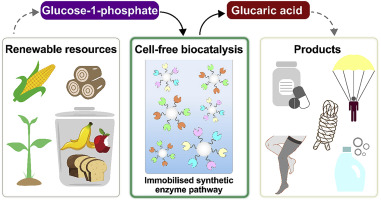Metabolic Engineering ( IF 6.8 ) Pub Date : 2019-11-11 , DOI: 10.1016/j.ymben.2019.11.003 Kerstin Petroll 1 , Andrew Care 2 , Peter L Bergquist 3 , Anwar Sunna 2

|
Glucaric acid (GlucA) is a valuable glucose-derived chemical with promising applications as a biodegradable and biocompatible chemical in the manufacturing of plastics, detergents and drugs. Recently, there has been a significant focus on producing GlucA microbially (in vivo) from renewable materials such as glucose, sucrose and myo-inositol. However, these in vivo GlucA production processes generally lack efficiency due to toxicity problems, metabolite competition and suboptimal enzyme ratios. Synthetic biology and accompanying cell-free biocatalysis have been proposed as a viable approach to overcome many of these limitations. However, cell-free biocatalysis faces its own limitations for industrial applications due to high enzyme costs and cofactor consumption. We have constructed a cell-free GlucA pathway and demonstrated a novel framework to overcome limitations of cell-free biocatalysis by i) the combination of both thermostable and mesophilic enzymes, ii) incorporation of a cofactor regeneration system and iii) immobilisation and recycling of the pathway enzymes. The cell-free production of GlucA was achieved from glucose-1-phosphate with a titre of 14.1 ± 0.9 mM (3.0 ± 0.2 g l−1) and a molar yield of 35.2 ± 2.3% using non-immobilised enzymes, and a titre of 8.1 ± 0.2 mM (1.70 ± 0.04 g l−1) and a molar yield of 20.2 ± 0.5% using immobilised enzymes with a total reaction time of 10 h. The resulting productivities (0.30 ± 0.02 g/h/l for free enzymes and 0.170 ± 0.004 g/h/l for immobilised enzymes) are the highest productivities so far reported for glucaric acid production using a synthetic enzyme pathway.
中文翻译:

一种无细胞酶法生产葡糖二酸的新框架。
葡萄糖酸(GlucA)是一种有价值的葡萄糖衍生化学品,在塑料,洗涤剂和药物的制造中作为可生物降解和生物相容性化学品具有广阔的应用前景。近来,人们一直非常关注由可再生材料如葡萄糖,蔗糖和肌醇生产微生物(体内)GlucA 。但是,这些体内由于毒性问题,代谢物竞争和次优酶比,GlucA生产过程通常缺乏效率。已经提出了合成生物学和伴随的无细胞生物催化作为克服许多这些局限性的可行方法。然而,由于高酶成本和辅因子消耗,无细胞生物催化在工业应用中面临其自身的局限性。我们已经构建了无细胞的GlucA途径,并展示了一个新的框架来克服无细胞的生物催化的局限性,方法是:i)热稳定酶和嗜温酶的结合; ii)辅因子再生系统的结合; iii)固定化和循环利用途径酶。GlucA的无细胞生产是由1-磷酸葡萄糖获得的,滴度为14.1±0.9 mM(3.0±0.2 g l-1)和使用非固定化酶的摩尔产率为35.2±2.3%,滴定度为8.1±0.2 mM(1.70±0.04 g l -1),使用固定化酶的摩尔产率为20.2±0.5%,总反应10小时的时间。所得生产率(游离酶为0.30±0.02 g / h / l,固定酶为0.170±0.004 g / h / l)是迄今为止报道的使用合成酶途径生产葡糖二酸的最高生产率。










































 京公网安备 11010802027423号
京公网安备 11010802027423号